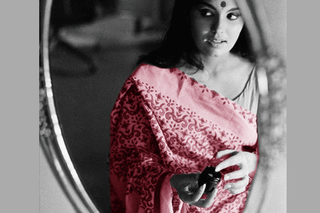
A Love Letter to Pre‑Loved, Budget‑Friendly Fashion
Sometimes, the most sustainable fashion comes straight from your mother’s closet.

Somewhere in the midst of my first year away from home, I began sleeping in my mother’s kurtis. Two weeks before I had left, she dropped a pile of clothes on my bed to choose from and alter what I liked for my own use. They were no rare vintage treasures — merely fast fashion from when fast fashion was just a good deal, cared for and preserved till she’d used them enough to pass it on to me.
I was at an odd crossroads then, new to fashion — confused if a good old thing is a delight to wear, or a tell of how staid your taste is. But I needed to look like an adult at the workplace and mothers are pretty good at looking like adults, so here I was, packing away a good quarter of my mother’s wardrobe to take to a new city. However, my problems in the big city had nothing to do with what I wore.The ‘chill’ advertising industry I threw myself into was less populated with well-dressed women who’d nod appreciatively at your attire or say ‘nice shirt,’ than it was with boorish men who could just straight up call you ugly for kicks.
There’s a sort of primal confusion that accompanies finding out that the armor with which you had prepared to face the world was practically useless. There’s this dream that apparel brands and aesthetic Instagram shoots sell you about how your clothes can imbibe you with a certain protective power, keeping you safe from bullies and gatekeepers. Everyone has looked at a perfectly done-up woman and thought, “Who could dare hurt someone like that?” Of course, the realization that the things marketed to you are a lie is pretty much a coming-of-age ritual now.
Related on The Swaddle:
Fashion Still Thriving Off Low‑Paid Women Garment Makers
Outside, I laughed off mean comments, because everyone knows how woefully inept 20-year-old girls are at standing up for themselves. Inside, talking about it was still never an option. When you’ve left a very protective home for the first time, showcasing weakness is inviting more pleas to just return home. Sleeping in those kurtis, still warm and thrumming softly of my mother’s presence, was balm for days when the tired and the too-much knotted itself around my body and squeezed hard enough to choke. Since then, I’ve held a secret reverence for the clothes my mother passes on to me, often finding treasures like a white shirt of the pliant sort with a mandarin collar and gold buttons, a stiff pair of indestructible jeans, and old, soft scarves picked up from a boat-shop in Kashmir.
Using my mother’s clothes was a welcome alternative to spending large amounts frequently at the mall. Everyone who keeps up with fashion and/or climate change is aware of the fast, cheaply produced fashion menace and the slow, sustainable solution. As a young, environmentally conscious person, I saved up for months to spend money on one blouse and one skirt from brands who had transparent, ethical production processes — spending approximately Rs. 5,000 to buy both on sale. Though the blouse was cut to fit me just right and the skirt was structured to sway as I liked it, the sheer cost of replacing fast fashion with the ethical alternative made my exorbitant Mumbai rent sound reasonable. For anyone with bills to pay, sustainable fashion is clearly not the end-all answer, though it does present a lovely solution for the occasional indulgence. Besides, the earthy, loose fitting aesthetic of ethical fashion brands might not flatter every body or be everyone’s cup of tea.
Related on The Swaddle:
What Keeps Many Girls from Loving Their Bodies
There is a third alternative, however: it didn’t take me, habitual raider of my mother’s closet, a lot to figure that pre-loved clothes and a few hundred bucks for a couple of snips and darts was the ultimate sustainable fashion resource. The advantage was twofold: one was that this option was nearly free, except for the cost of altering. The second benefit was the cyclical nature of fashion trends. The jeans I took from my mother’s closet were flared, just in time for when old-school flared jeans were everywhere. A pair of high-waisted harem pants (borrowed just when high-waisted silhouettes were back) kept my belly snug for when crop top cravings happened in winter.
Besides, the environmental impact of reusing old clothes is formidable, if practiced on a larger scale; fast fashion currently takes up an extraordinary amount of water, runs on tight supply chains built on the backs of underpaid workers, lives a short life in a closet and eventually clogs landfills with material that will take decades to degrade. Increasing the life cycle of products one already has, via repair and reuse, kills the need to repopulate your closet with similar products. Giving away or re-selling old clothes helps clog landfills a little less.
The only drawback to raiding other people’s closets for treasures is the possibility of your and their personal style being poles apart. When your mother’s a saree lady and you’re the trousers sort — a little imagination and a tailor (or a YouTube tutorial and sewing machines) could turn a saree into a pair of trousers, or a dress. If the divide is too much, various pre-loved and vintage fashion online boutique stores and pop-ups often come to the rescue. In the Indian market, both luxury vintage boutique shops and thrift store options are gaining prominence for re-selling pre-loved fast fashion at affordable rates.
Divya Saini, the founder of Indian vintage label Bodements, found her love for vintage in the outskirts of Paris. She said,”While sourcing clothes for one of my shoots, a friend got me to a store that had beautiful blouses and jackets amongst many things. I bought a lot [of] articles for my different projects and clients and a few things for my friends too. What few people know is that my initial plan with Bodements was solely to rent these clothes to a very exclusive type of clients and use them for some of my shoots. But all my friends loved how special each piece was, how it told a story and how they embodied a style and a positive philosophy. They all asked for more. It was then that I realized that my love for sharing little treasures which I bring from trips, could actually grow into something bigger.”
Saini’s most beloved thrift finds include a late-80s jacket with a Freddie Mercury vibe from Berlin, and an Emanuelle Khan jacket from the late 60s with a unique dragon-like collar — “the kind of garment you can only find in France.” She is one of the most vocal proponents of sustainable living, often sharing information regarding the dangers of human excess and climate change to her formidable Instagram following. With respect to the Indian market, her journey, though rewarding, has not been easy.
“A lot of Indians are still reluctant [towards] the idea of wearing pre-loved clothes, but mentalities a changing,” she said. “Vintage is also about quality, and Indians do care about it. Mass-produced, standardized and cheap factory items have replaced many goods once made by skilled and traditional artisans. Even if vintage in India doesn’t yet revolve around ethnic fashion, we believe it creates awareness about the importance of craftsmanship,” she said.
Currently, a good 50% of my closet is pre-loved. While my disposal habits are awful, I’m slowly learning to mend and re-wear till my clothes fall apart. Beyond the occasional joy of fitting a trend or just personal style, the things I wear still hold memory and warmth, soothing frayed nerves and gathering my wits, while eliciting a lot more ‘Nice shirt!’s these days.
Aditi Murti is a culture writer at The Swaddle. Previously, she worked as a freelance journalist focused on gender and cities. Find her on social media @aditimurti.
Related


Is This Normal? “I Tell Myself Stories at Night in Order to Fall Asleep”
